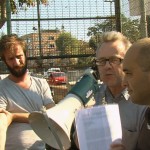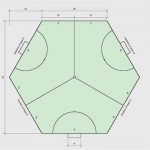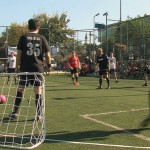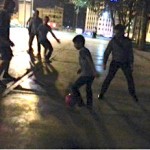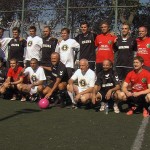Three Sided Football
Thomas BüschThe next Three-Sided Football World Cup will take place June 1-3 in Madrid. The alternative World Cup tournament shortly before the official one kicks off in Russia. Filippo Ricci, one of the long-standing Philosophy Football players, is planning to hold it in Madrid, where three sided football have been played before and where he is based as a football correspondent.
It is open to all regions, nations, towns and villages and Philosophy Football players would be delighted to hear from interested teams. Filippo is organizing the venue at the moment. Please contact Geoff Andrews from the Philosophy Football FC if you’re interested in sending a team, for what is intended to be a great, convivial and unofficial celebration of the beautiful game.
The first Three-Sided Cup took place 2014 in Denmark from Friday 23rd May until Sunday 25th May in cooperation with the Asger Jorn Museum in Silkeborg.
[...]
Read more...
Thomas Büsch100 Years Asger Jorn
The exhibition Traces – 100 Years Asger Jorn at the Cobra Museum for modern art in Amsterdam marks the hundredth anniversary of the birth of Asger Jorn (1914-1973), with works by Jorn and selected works by his contemporaries. Asger Jorn is known as the artist who invented in 1964 the three sided football match to explain his notion of triolectics, his refinement on the concept of dialectic, as well as to disrupt one’s everyday idea of football . The first world cup of three sided football took place May 2014 in Denmark.
Traces – 100 Years Asger Jorn includes two partial exhibitions: Asger Jorn – The Secret of Art, a unique gift from the Otto van de Loo family of some 150 works on paper, and A Way of Making, a new project by contemporary artists Frederique Bergholtz and Maria Pask.
Asger Jorn is known as one of the founders of Cobra (1948-1951), the International Situationists (1957-1972) and other groups, and worked in a wide variety of media.
Jorn successfully brought his diverse interests together in an organic way, in a comprehensive theory about art and life, based on a very explicit idea of the role of the artist in society. In short, Asger Jorn left a legacy of artworks, writings, a way of thinking and an attitude that continue to be an inspiration for today’s artists and thinkers.
The Secret of Art
Donation of 150 works by Asger Jorn
“The secret of art consists in the simple fact that it is more blessed to give than to take, but also that this blessedness is dependent upon voluntary giving, so that what is given is felt as a surplus, a wealth, not a duty.”. Asger Jorn, Value and Economy (1959)
The Cobra Museum of Modern Art has recently received a beautiful and extensive donation from Otto van der Loo and family. It is now on view in its entirety for the first time. This generous gift includes, amongst others, a number of the first colour etchings that Jorn completed in 1958, as well as the complete Schweizer Suite series (1954) and several dynamic woodcuts, in which Jorn subtly and sometimes also humorously played with the grain of the wood, which ran in different directions.
About Das offene Versteck, from 1970, one of the works from the Van der Loo donation, Rudi Fuchs wrote, ‘The colourful thicket in the print by Jorn is as askew as the motion of his hand. Tomorrow it can be different. Art dazzlingly keeps beavering away.’
Cobra Museum
Sandbergplein 1
1181 ZX Amsterdam
Netherlands
Sunday 28th September – 18th January 2015
Opening:
Sunday 28th September 11:00 – 17:00 [...]
Read more...
Johanna FröhlichThe World Cup is an event we truly stand behind, like and support. All the teams from different countries gather together not only to find a winner and to pass the ball to each other but also to find a common, friendly connection over sport.
This laudatory sentences do not refer to the Fifa World Cup that currently takes place in Brazil. It refers to another football World Cup – the Three Sided Football World Cup – that also took place this summer. It is the very first time that a World Cup of this special kind of football was realized. But why is it so special? And why do we like it so much?
The concept and the rules
The game was conceived by the Danish artist and situationist Asger Jorn who was born on the 3rd of March 100 years ago. He based his idea on a variation of the Marxist theory of dialectic materialism: the idea that society is driven forward by the struggle between haves and have-nots. Since then three-sided football has been played occasionally at festivals and embraced by the quirkier end of the anti-globalisation movement. The rules are simple: the teams play on a hexagonal pitch with three goals and the team which conceved the fewest goals wins. That makes it to a game of alliances and betrayal. The game deconstructs the confrontational and bi-polar nature of conventional football as an analogy of class struggle in which the referee stands as a representative of the state and media apparatus, and to present him as a neutral mediator of the continuing class struggle in the political process.
The World Cup 2014 in Denmark
To keep Jorn´s visions alive and to celebrate the variety of football, the World Cup 2014 in Denmark took place from Friday 23rd May until Sunday 25th May in cooperation with the Asger Jorn Museum in Silkeborg. Teams from France, Germany, Poland, England, Lithuania (who decided to represent Uruguay instead of their nation) and of course Denmark sought to win the Cup. Aftert a weekend of a series of qualitative football, the Danish team Silkeborg KFUM was crowned to be the Champion.
According to the participants, there will be definitely another Three-Sided Football World Cup and Germany is likely to become the host for the next Cup in three years.
A video of champagne/the champions
[...]
Read more...
Thomas BüschOn the occasion of the 100 anniversary of Asger Jorns birthday on March 3rd the International Three Sided Football Federation together with Museum Jorn Silkeborg will be hosting the first World Cup in Three Sided Football ever held – and you are invited to participate. Teams from 8 different European countries will participate in the World Cup tournament taking place Saturday 24th May.
The event – taking place from Friday 23rd May until Sunday 25th May – will start off by a symposium held at the Museum Jorn Friday 23rd May, where important players, thinkers of triolectic football, and players within the development of the game will be brought together. Asger Jorn being the originator of the game, Museum Jorn is delighted to bring the game back to its roots in Silkeborg.
The symposium held Friday (registration necessary) as well as the World Cup tournament held Saturday are public events and you can get further information about both events on our website as soon as all the details for the program are scheduled.
Launch of the International Three Sided Football Federation in Istanbul 2013
Don’t miss the first Three Sided Football World Cup.
Museum Jorn Silkeborg
Gudenåvej 7-9, DK 8600 Silkeborg, Denmark
May 23rd – 25th 2014 [...]
Read more...
Thomas BüschThree-sided football
It seems like a typical Sunday afternoon game of football, but there’s a big difference – there are three teams on the pitch.
Deptford 3S Football Club is playing Philosophy Football FC and Strategic Optimists FC, at the same time.
This leads to all sorts of tactical subtleties, as BBC News discovered at a match in New Cross in London.
Video journalists: Dan Curtis and Tom Beal.
First published by BBC News Magazine
[...]
Read more...
Sabine Küper
In 2013 Istanbul got the centre of a miracle that spreaded across whole Turkey. The urban transformation policy of the government caused a political uprising that turned to massdemonstrations, massive police violence and detentions. But more then all it made Turkey one of the spots with the most creative civilian resistance movement on earth. Viva Gezi!
Inenart featured the highlights of the protests but also the artists contributions prior and during the uprisings. We focused on the rapid and dramatic transformation of the urban landscape of Istanbul and organised a three-sided Football game in solidarity with the Gei protests in the frame of the parallell events of the 13th art Biennial in Istanbul.
In the beginning of 2014 we will have been online for one year now. 2013 was a stormu year for Turkey. The Gezi Protests starting end of May shifted the political culture of Turkey sustainable. We want to continue to be a part of this.
[...]
Read more...
Lousia DöderleinInEnArt proudly presents the video about the first three-sided football match in Turkey which took place in the framework of the 13th Biennial on September 14th, 2013 at the Football Pitch of Kadir Has University in front of the Golden Horn.
It was a great afternoon with a lot of fun, great people and inspiring encounters!
It would not have been possible without the help of: Asena Hayal, Tan Cemal Genac (for the trailer and support during the match), Sabine Küper-Büsch, Thomas Büsch and Louisa Döderlein, thank you to all of you.
Also a big thanks to: Philosophy Football FC from the UK, Dynamo Windrad from Germany and Ayazma Football Club from Turkey, the referee Halil İbrahim Dinçdağ, and Genco Gülan for the trophies. [...]
Read more...
Thomas BüschExcerpt of Ally Clow reports on one of Philosophy Football FC’s most extraordinary events yet.
After the match on September 14th in Istanbul
The post-match celebrations were relatively muted because, although the sweltering heat of the previous day hadn’t carried over, it was still very warm and everyone wearing a red shirt was thoroughly exhausted. After some photos, a lot of handshakes and some press and television interviews, Turkish artist Genco Gülan who presented the teams with their medals: bananas with the words “Golden Horn” written on their skins, a suitably Dadaist touch to remind everyone that they were, after all, here as part if the Istanbul Bienniale. From the pitch, we travelled to a nearby tavern and indulged in a large feast, watching as the locals ordered a yard of meat on a skewer and baked roasted lamb cooked inside a salt crust that had to be opened with a crowbar. Our hosts Thomas and Sabine invited the three teams back to their apartment near Taksim Square and Gezi Park, the root of the initial protests in June when the government revealed they were going to build a shopping mall on the park.
Thomas and Sabine were incredible hosts: nothing was too much trouble for them and they showed genuine warmth toward us and seemed to think the day was a great success. Their apartment was a wonder and overlooked the Bosphorous that separates the European side of Istanbul from the Asian side and it was a wonderful evening. Some of the Turks wanted to know where ‘Wayne Rooney’ (ie Henry) was and joked that he had something against their country because he only seemed to score into their goal. Later on at around 11.30pm the cartoonist and animator Tan Cemal Genc, who had created the wonderful animated ‘trailer’ for the match, enquired if anyone wanted to go out to a bar. We all said yes and after many long farewells to our hosts, we left. Tan took us to Taksim Square. Even setting foot on the square was a powerful experience, knowing that part of the reason for our visit was the events that had unfolded there over the last few months. It was also intriguing because the idea of playing our match on the square itself had been mooted at several points in recent weeks, but the general consensus was that it would have been too dangerous because the police were watching the square for any subversive activity. The likelihood was the match would be stopped very quickly and further action may be taken. We stepped foot on the square and walked up to a central section slightly higher than its borders, lamenting that, although the match had been fantastic, it would have been an incredible experience to hold the match here. I don’t know who it was who asked if anyone had a ball, but Henry produced the match ball and we started to kick the it around between us.
Watching this, Mark moved some of our kit bags around to create six goalposts, roughly equidistant from each other – and we all knew what was about to happen. There was an undeniable excitement running through us all, a true shared experience that was exhilarating; could we get away with playing a 3sided football match on the site of the recent Turkish protests? We played for 5 minutes or so, attracting some bemused looks from the locals, but eventually some asked to join in. To start with, two men in their early twenties, then two boys of about 11 or 12, and all were clearly loving being part of something so spontaneous and unexpected. They also soon realised they could pass to another team and one of the young boys realised that it would be fun to receive a pass from someone then directly attack their goal. This was 3sided football as pure as it gets, spontaneous and peaceful yet retaining the concepts of collaboration and deviance in the pursuit of victory. Mark called for the end of the first rotation, the structure of a complete game had been created and while scores were kept, no one really cared about the result.
For about 40 minutes that night, football’s most powerful force was spontaneously recreated: the power to bring pure joy to people. It was joyful for us because we were playing in the most symbolically potent area connected to the popular protests in Istanbul, and we were also gaining pleasure from seeing how happy it was making the locals who were taking part and watching. After the match, we gave the local men the remaining red ‘Barbarian’ shirts, one of them demanding Ally’s match shirt, sweat and all. It was awesome and inspiring. While we were playing, an old man walked across the ‘pitch’, smelled the air and said ‘I smell freedom here’.
Read the whole wonderful reports at Philosophy Football FC’s site [...]
Read more...
Thomas BüschOn September 14th at 4 pm the first ever three sided football match took place in Istanbul on the banks of the Halic (Golden Horn).
InEnArt organized the three sided fooball match in the frame of parallel events of the 13th International Istanbul Biennial on September 14th in cooperation with Philosophy Football FC UK, Dynamo Windrad Germany and Ayazma Football Club Turkey.
A large crowd welcomed the event and were enthusiastic about this variation of association football with the three squads instead of the usual two.
The three teams shared the broad cultural ideas of the Biennial with their performance. Three-sided football is seen as an artistic form, a ‘spectacle’ and a chance to demonstrate that different views, ideas and approaches can be expressed freely and spontaneously in ways that promote dialogue and cooperation rather than conflict and division.
Geoff Andrews from the Philosophy Football FC launched the Three Sided Football Federation at this tournament in Istanbul.
Halil İbrahim Dinçdağ, who got fired by the Turkish Football Federation in 2009, was the referee.
Winner of the match was the Philosophy Football FC from the UK.
After the match Turkish artist Genco Gülan presented bananas to the teams as a symbolic cup.
We thank all the participating squads and the team from InEnArt (Tan Cemal Genc, Sabine Küper-Büsch, Asena Hayal, Thomas Büsch and Louisa Döderlein) to make this match an unforgettable ‘spectacle’.-
With this match we will offering a positive contribution to the recent protests in Turkey. [...]
Read more...
Thomas BüschIn the frame of the Three Sided Football match in the afternoon, the squads played an after match late at night on Taksim Square in front of Gezi Park. [...]
Read more...




